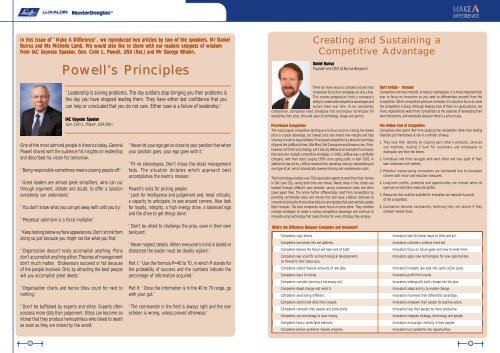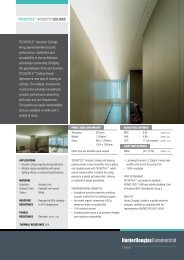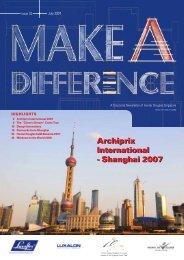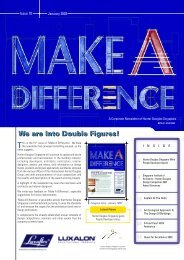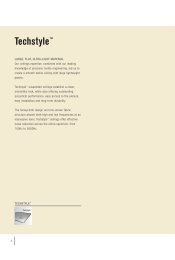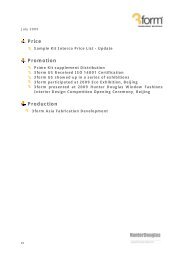Hunter Douglas hosts 4,000 at first-ever International Alliance ...
Hunter Douglas hosts 4,000 at first-ever International Alliance ...
Hunter Douglas hosts 4,000 at first-ever International Alliance ...
You also want an ePaper? Increase the reach of your titles
YUMPU automatically turns print PDFs into web optimized ePapers that Google loves.
In this issue of “ Make A Difference” , we reproduced two articles by two of the speakers, Mr DanielBurrus and Ms Michelle Lamb. We e would also like to share with our readers snippets of wisdomfrom IAC Keynote Speaker, , Gen. Colin L. Powell, USA (Ret.) and Mr George Whalin.Powell’s PrinciplesCre<strong>at</strong>ing and Sustaining aCompetitive AdvantageDaniel BurrusFounder and CEO of Burrus ResearchOne of the most admired people in America today, GeneralPowell shared with the audience his insights on leadershipand described his vision for tomorrow.“ Being responsible sometimes means pissing people off.”“ Gre<strong>at</strong> leaders are almost gre<strong>at</strong> simplifiers, who can cutthrough argument, deb<strong>at</strong>e and doubt, to offer a solution<strong>ever</strong>ybody can understand.”“ You don’t know wh<strong>at</strong> you can get away with until you try.”“ Perpetual optimism is a force multiplier.”“ Leadership is solving problems. The day soldiers stop bringing you their problems isthe day you have stopped leading them. They have either lost confidence th<strong>at</strong> youcan help or concluded th<strong>at</strong> you do not care. Either case is a failure of leadership.”IAC Keynote SpeakerGen. Colin L. Powell , USA (Ret.)“ Keep looking below surface appearances. Don’t shrink fromdoing so just because you might not like wh<strong>at</strong> you find.”“ Organis<strong>at</strong>ion doesn’t really accomplish anything. Plansdon’t accomplish anything either. Theories of managementdon’t much m<strong>at</strong>ter. Endeavours succeed or fail becauseof the people involved. Only by <strong>at</strong>tracting the best peoplewill you accomplish gre<strong>at</strong> deeds.”“ Organis<strong>at</strong>ion charts and hence titles count for next tonothing.”“ Don’t be buffaloed by experts and elites. Experts oftenpossess more d<strong>at</strong>a than judgement. Elites can become soinbred th<strong>at</strong> they produce hemophiliacs who bleed to de<strong>at</strong>has soon as they are nicked by the world.”“ N<strong>ever</strong> let your ego get so close to your position th<strong>at</strong> whenyour position goes, your ego goes with it.”“ Fit no stereotypes. Don’t chase the l<strong>at</strong>est managementfads. The situ<strong>at</strong>ion dict<strong>at</strong>es which approach bestaccomplishes the team’s mission.”Powell’s rules for picking people:“ Look for intelligence and judgement and, most critically,a capacity to anticip<strong>at</strong>e, to see around corners. Also lookfor loyalty, integrity, a high energy drive, a balanced egoand the drive to get things done.”“ Don’t be afraid to challenge the pros, even in their ownbackyard.”“ N<strong>ever</strong> neglect details. When <strong>ever</strong>yone’s mind is dulled ordistracted the leader must be doubly vigilant.”Part I: “ Use the formula P=40 to 70, in which P stands forthe probability of success and the numbers indic<strong>at</strong>e thepercentage of inform<strong>at</strong>ion acquired.”Part II: “ Once the inform<strong>at</strong>ion is in the 40 to 70 range, gowith your gut.”“ The commander in the field is always right and the rearechelon is wrong, unless proved otherwise.”There are many ways to compete and yet mostcompanies focus their str<strong>at</strong>egies on only a few.This narrow perspective limits a company’sability to cre<strong>at</strong>e solid competitive advantages andsustain them over time. To be consistentlycompetitive, companies need str<strong>at</strong>egies th<strong>at</strong> encompass techniques for<strong>ever</strong>ything from price, time and value to technology, image and service.Price-Based CompetitionThe most popular competitive technique is to focus on price. Having the lowestprice is a gre<strong>at</strong> advantage, but lowest price also means low margins and highvolumes in order to stay profitable. Price-based competition is a favourite techniqueof giants like JetBlue Airlines, Wal-Mart, Dell Computers and Amazon.com. Price,how<strong>ever</strong>, isn’t their only str<strong>at</strong>egy. Let’s look <strong>at</strong> JetBlue as an example of a companyth<strong>at</strong> executes multiple competitive str<strong>at</strong>egies. In 2006, JetBlue was a profitablecompany, with their stock surging 156% since going public in April 2002. Inaddition to low prices, JetBlue lowered their oper<strong>at</strong>ing costs by standardising toone type of jet, which dram<strong>at</strong>ically lowered training and maintenance costs.Their technology enables over 700 reserv<strong>at</strong>ion agents to work from their homesin Salt Lake City, saving both time and money. Nearly three in four tickets arebooked through JetBlue’s own website, saving commission costs and othertravel agent fees. The airline further differenti<strong>at</strong>es itself from competitors byproviding comfortable se<strong>at</strong>s and movies th<strong>at</strong> add value. JetBlue continues toinnov<strong>at</strong>e by being the <strong>first</strong> to allow pilots to carry laptops th<strong>at</strong> autom<strong>at</strong>ically upd<strong>at</strong>eflight manuals. The best companies n<strong>ever</strong> focus on price alone. They combinemultiple str<strong>at</strong>egies to cre<strong>at</strong>e a lasting competitive advantage and continue toinnov<strong>at</strong>e using technology th<strong>at</strong> raises the bar for <strong>ever</strong>y str<strong>at</strong>egy they employ.Wh<strong>at</strong>’s the Difference Between Competers and Innov<strong>at</strong>ors?Competers copy others.Competers are locked into set p<strong>at</strong>terns.Competers believe the future will take care of itself.Competers see scientific and technological developmentsas thre<strong>at</strong>s to their st<strong>at</strong>us quo.Competers collect massive amounts of raw d<strong>at</strong>a.Competers react to trends.Competers consider planning a necessary evil.Competers dread change and resist it.Competers avoid being different.Competers control and direct their people.Competers complain their people lack productivity.Competers use technology to save money.Competers favour predictable behavior.Competers believe problems impede progress.Don’t Imit<strong>at</strong>e – Innov<strong>at</strong>eCompetition will only intensify. In today’s marketplace, it is more important than<strong>ever</strong> to focus on innov<strong>at</strong>ion as you seek to differenti<strong>at</strong>e yourself from thecompetition. When competitive pressure increases, it is n<strong>at</strong>ural to focus on wh<strong>at</strong>the competition is doing. Although keeping track of them is a good practice, toomany organis<strong>at</strong>ions w<strong>at</strong>ch their competitors <strong>at</strong> the expense of developing theirown innov<strong>at</strong>ions, and eventually discover there’s a price to pay.The Hidden Cost of CompetitionCompanies who spend their time studying the competition r<strong>at</strong>her than lookinginternally put themselves <strong>at</strong> risk in a number of ways:1. They lose their identity by copying each other’s products, servicesand methods, making it hard for customers and employees todistinguish one from the others.2. Individuals and firms struggle with each other and lose sight of theirown customers and markets.3. Potential money-saving innov<strong>at</strong>ions are overlooked due to excessiveconcern with minor cost-reduction measures.4. Long-term profits, problems and opportunities are missed when alleyes are on short-term sales and profits.5. Resources th<strong>at</strong> could be available for innov<strong>at</strong>ion are reduced in pursuitof the competition.6. Companies become complacent, believing they are secure if theymaintain market share.Innov<strong>at</strong>ors look for better ways to think and act.Innov<strong>at</strong>ors cultiv<strong>at</strong>e a cre<strong>at</strong>ive mind set.Innov<strong>at</strong>ors focus on future goals and how to meet them.Innov<strong>at</strong>ors apply new technologies for new opportunities.Innov<strong>at</strong>ors transl<strong>at</strong>e raw d<strong>at</strong>a into useful action plans.Innov<strong>at</strong>ors profit from trends.Innov<strong>at</strong>ors str<strong>at</strong>egically build change into the plan.Innov<strong>at</strong>ors adapt and try to master change.Innov<strong>at</strong>ors maximise their differential advantage.Innov<strong>at</strong>ors empower their people for positive action.Innov<strong>at</strong>ors help their people be more productive.Innov<strong>at</strong>ors integr<strong>at</strong>e str<strong>at</strong>egy, technology and people.Innov<strong>at</strong>ors encourage cre<strong>at</strong>ivity in their people.Innov<strong>at</strong>ors turn problems into opportunities.1011


